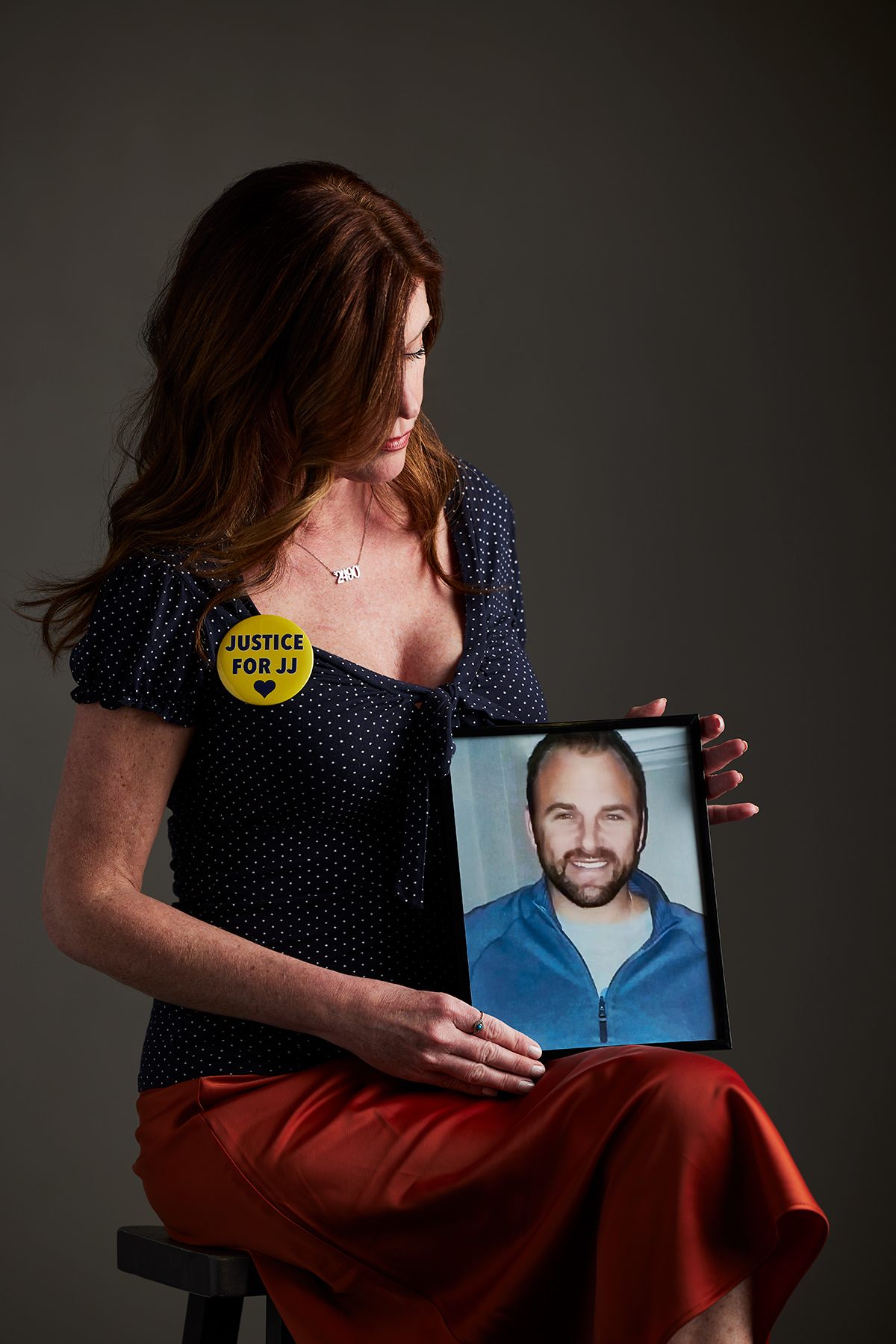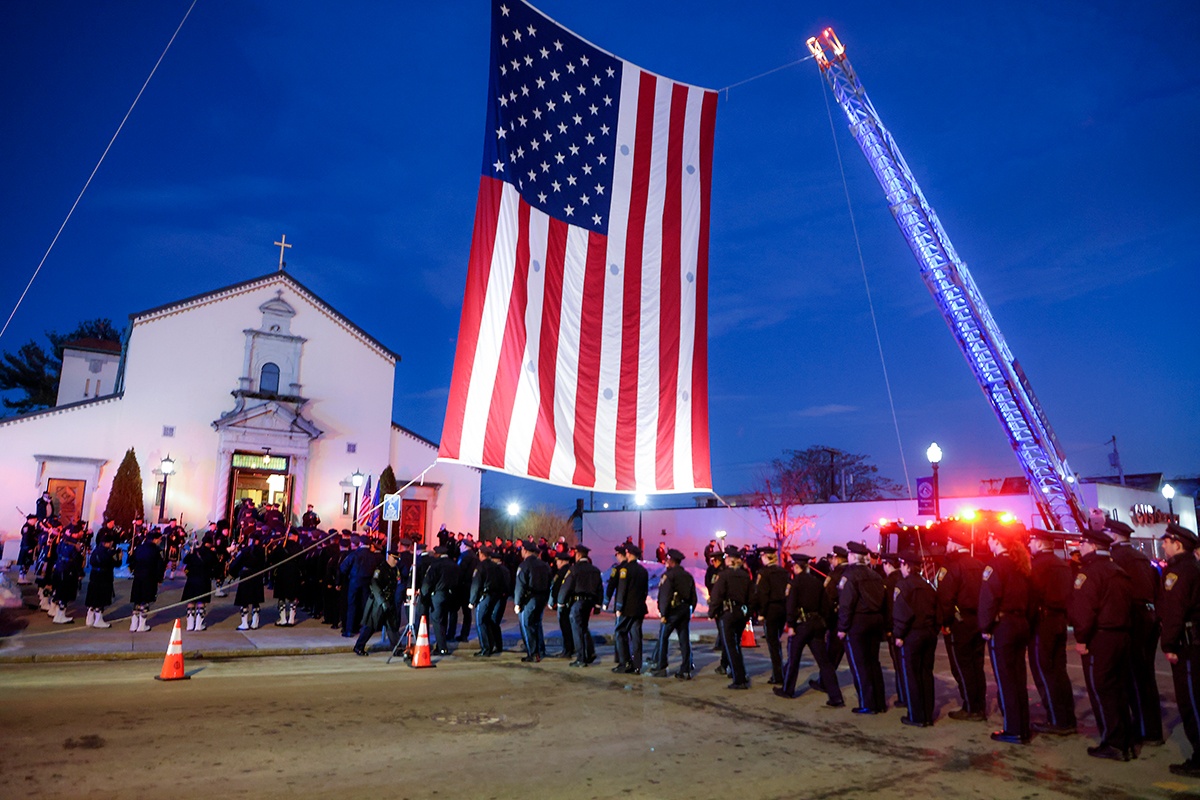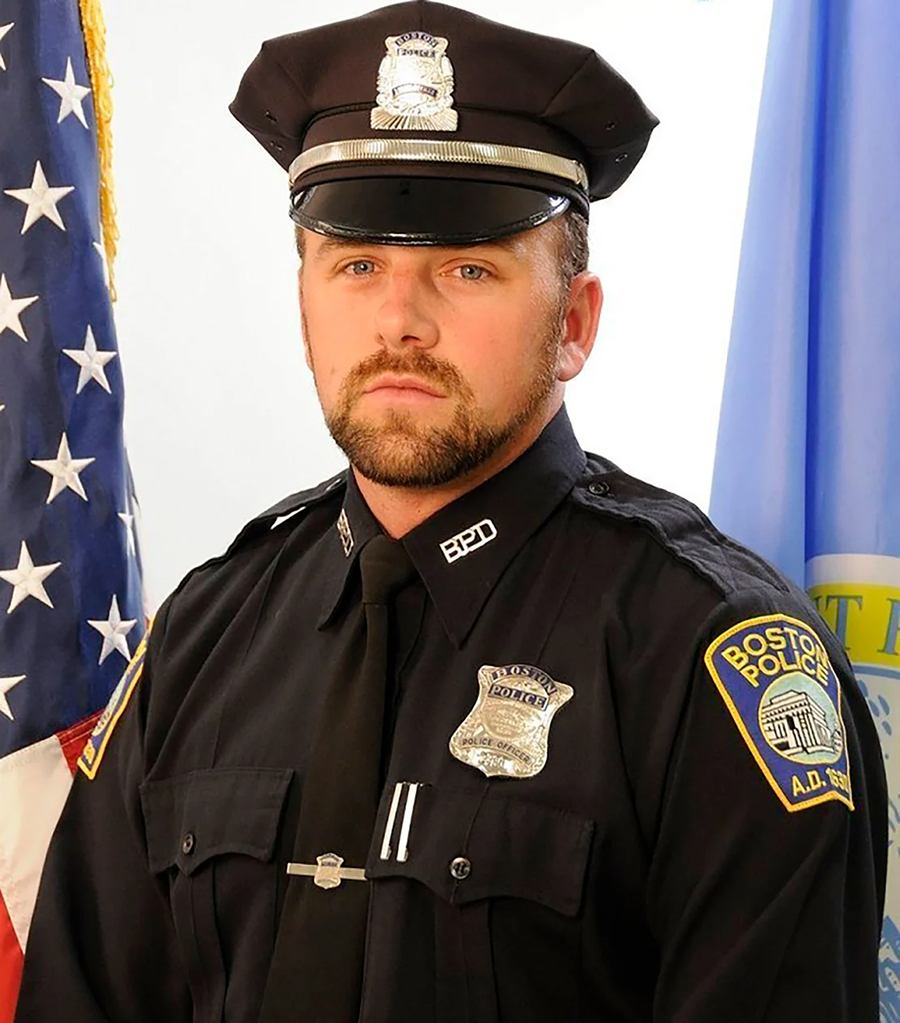Remembering the Real Victim in the Karen Read Case, My Friend John O’Keefe
Karen Read, the Massachusetts woman accused of killing her Boston Police officer boyfriend, has been painted as a scapegoat, a symbol, and a true-crime celebrity. But what about the man who died—and the people closest to him?

The author, with a portrait of her good friend, John O’Keefe.
My phone was still on silent when I woke the morning of January 30, 2022, to four missed calls and a text from a friend that read, “Call me when you get up. I think something happened to John.” I dialed her number. “John who?” I asked as soon as she answered. “Your John. John O’Keefe,” she said, explaining that she had seen a tribute to John on Facebook that indicated he had passed away.
While technically my ex-boyfriend, John was so much more than that. We met in 2001 and had a big love that evolved into a friendship spanning more than 20 years. We had seen each other through some hard times. We had a special connection.
I immediately hung up and called John’s cell—I knew he would answer, explain the mix-up, and we’d laugh about it. At least, that’s what I told myself. But John didn’t answer; instead, the phone went straight to voicemail. I tried him again. Voicemail.
I learned later that John’s brother, Paul, had been awakened the previous morning by a call from their mother relaying that John had been found in a snowbank. Paul was the first to arrive at the hospital, where he sat for 45 minutes alone while doctors tried to warm John up. When his parents arrived, all three were escorted into a small room by a hospital employee and waited for a doctor and nurse to come in. “They were still wearing masks,” Paul told me. “But I could tell by the look in their eyes.” While the nightmare began differently for each of John’s loved ones, it ended the same for all of us. He was gone.
John’s wake was an emotionally agonizing yet poignant tribute to a man defined by his deeds and a life rich with purpose as a parent and a 16-year veteran of the Boston Police Department. Given the magnitude of the turnout, the gathering was held inside the church of St. Francis of Assisi in his hometown of Braintree. More than a thousand people waited patiently in the biting rawness of that frosty February day to pay their respects. Officers from across the country, wearing pristine uniforms and expressions of devastation, formed a procession led by Boston Mayor Michelle Wu.

The procession outside Braintree’s St. Francis of Assisi Church in remembrance of Boston Police officer John O’Keefe, III on Feb. 6, 2022. / Photo by Matthew J. Lee/The Boston Globe via Getty Images
As I inched closer toward the blue coffin, my trembling legs turned to lead. I was not ready to face this reality, the finality of this moment with John. Adorned in his police uniform, he was as startlingly handsome in death as he had been in life.
If the wake felt like floating through a bad dream, the funeral the next day proved even more surreal. Among the parishioners, a distinct cluster of faces were painfully familiar. We shared nods of comradery from across the pews. We had been here before. In 2013, John had lost his beloved sister, Kristen, to a brain tumor, followed by the suicide of his close friend and fellow officer just eight days later. Two months after that, his sister’s husband died of a heart attack. As the procession approached, memories of the prior funerals came rushing back to me. I recalled standing at the end of the pew, as I did now, when John reached out to squeeze my hand. Now, it was John in the coffin, which happened to pause right in front of me for the draping of the pall.
After the death of his sister and brother-in-law, John made the selfless decision to abandon the familiar bachelor life he had known to embrace the role of a single parent to his six-year-old niece and three-year-old nephew. He traded the city for suburban life in Canton and transferred to a safer position for the sake of the children, who had already lost so much.
The children bestowed upon John the endearing nickname “JJ” and renewed his sense of hope when life seemed too bleak to carry on. It would be those children who would lose a third parent on the night John died.
During the service, Paul remembered his brother in a moving eulogy that evoked both laughter and tears. He spoke of their childhood, their closeness, and how John never left their sister Kristen’s side during her battle with cancer. Praising John for providing a home full of love for her children, he concluded with the haunting words, “We’ll take it from here.” Those were the very same words John said when he eulogized his sister nine years prior.
One of the most touching tributes that day was when hundreds of strangers, with their hands on their hearts and blue ribbons affixed to their clothing, lined the sidewalks along the funeral route from St. Francis church to the Blue Hill Cemetery in a demonstration of sorrow and solidarity with John’s family. As we basked in this outpouring of kindness, none of us could have foreseen that John’s parents and their last surviving child, Paul, were on the verge of being sucked into a toxic, conspiracy-fueled drama that would steal the solace they had found in the early days of their loss.
The Karen Read Case in Canton:
The Killing That Tore a Town Apart
Just a week before the funeral, prosecutors had charged John’s girlfriend, Karen Read, with vehicular homicide and manslaughter, later changing the charges to second-degree murder. Investigators concluded that she was intoxicated when she backed over John with her car after dropping him off at a late-night gathering, and then left him to die in the cold. His family also believed that Read was to blame.
What John’s family considered to be an open-and-shut case, though, was about to become anything but. In September 2022, Los Angeles–based criminal defense attorney Alan Jackson, who defended Kevin Spacey and Harvey Weinstein in sexual assault cases and is known for his flair in the courtroom, joined Read’s legal team. I sat with John’s family and friends in disbelief as Jackson transformed hearings into what felt like the set of a Hollywood whodunit, arguing that Read was framed. He told of extravagant theories that I and John’s family believe directly contradicted the facts of the case.
Still, the worst was yet to unfold outside the courtroom walls. A case that rightfully belonged within the confines of the legal system was soon converted into what felt to me and John’s family like an unofficial and unregulated trial playing out in the streets. After a blogger named Aidan Kearney (a.k.a. Turtleboy) began to write about the case, maintaining that Read was innocent and being framed, large numbers of his readers showed up alongside him at court hearings shouting and wearing shirts that read, “Free Karen Read.” Sensitive to the O’Keefe family’s suffering, these people were not: One of Read’s supporters used the online pseudonym “O’Keefe’s Frozen Corpse.” At a Halloween party to raise money for Read’s legal defense, one attendee used makeup to recreate the same wounds O’Keefe had on his arm. The cake at the party appeared to be decorated like blood-soaked snow.
Scenes from the “Free Karen Read” Halloween fundraiser.
I witnessed this scenario play out at a hearing on July 25, 2023. When Read showed up, her supporters showered her with a celebrity’s welcome. When John’s family arrived afterward, they asked court officers to let them use an alternative entrance to avoid walking through the echo of cheers for the woman accused of killing their son. The court denied the request, and when the victim’s loved ones walked into the courthouse, the crowd erupted into jeers and taunts.
Dazed, I gathered with John’s family in the hall. While most of us were visibly shaken, Paul stayed remarkably calm. He stood expressionless, watching the crowd through the door, hands in his pockets, exuding a quiet strength that reminded me of his brother.
After the hearing, Read’s supporters once again shouted insults at us. Someone who Paul recognized as a close friend of Read’s parents even hollered the phrase “cop killer” at him. While completely illogical—no one seems to believe that John’s own family murdered him—this is what Read’s supporters label anyone who doesn’t believe she is innocent, and it’s a term his family and I have had to desensitize ourselves to. I once asked Paul how he managed to show such remarkable restraint while under attack by Read supporters. “They’re misinformed. Misguided. So I just don’t engage,” he told me.
At a subsequent hearing, the pro-Read crowd—who seemed to keep increasing in number—once again harassed me, Paul, and other friends of John’s who had shown up to support the family. The enraged crowd chanted “Shame on you” in unison as we entered the courthouse. After the hearing, court officers warned us to refrain from exiting immediately “for our own safety.” We waited, only to find the crowd was waiting, too. We needed the protection of the state police to find our way safely to our cars, as the mob followed us, screaming “cop killers.”

Karen Read supporters protest outside a Dedham courthouse before one of Read’s Norfolk Superior Court appearances. / Photo by Jessica Rinaldi/The Boston Globe via Getty Images
Afterward, I reconvened with John’s friends and family at a restaurant far from the chaos to grapple with the surreal events that had just unfolded. Someone remarked that the scene was like something you’d see in a horror movie.
Those words brought back memories of John in the months following the loss of his sister, his brother-in-law, and his friend—a time when it seemed as though the light in his eyes had all but been extinguished. When people asked him how he was coping, he’d answer that he’d tell himself that none of it was real. “It’s only a movie,” I remember he used to say. “It’s only a movie.”
Making a difficult time even more harrowing, horrific pictures of John began to appear online. In one split-screen image, John’s smiling face was juxtaposed with snow drenched in his blood. One of the most painful moments for John’s family was when Turtleboy’s blog published leaked photos from the autopsy report, allowing morbidly curious readers to gawk at one of John’s most intimate and vulnerable moments.
Meanwhile, Read’s supporters became a fixture at every hearing as the case began garnering national headlines, with Read’s images splashed across media outlets—only now, she was depicted as the victim. The larger the crowds and the wider the media coverage, the more it seemed as though John’s legacy was fading into obscurity while the public celebrated the supposed innocence of the woman accused of murdering him. That, for the family, has been the most enduring pain of all. “In all of this chaos, it feels like John’s being forgotten,” Paul recently said to me. “And the person who stands accused of killing my brother is now being treated like the victim.”

John O’Keefe in uniform. / Courtesy of the Boston Police Department
As I write this in the run-up to Read’s trial, which at presstime was set to begin in mid-April, I can sense the frustration among John’s family and friends. We’ve grown tired of playing prosecutor outside of court. We’ve been forced to continuously dispel the defense team’s claims with concrete facts to strangers and even friends. We’ve watched expressions shift when we’ve succinctly explained the impossibility of what Read’s attorneys and supporters claim: that John was attacked by acquaintances (and their family dog) who then dumped John outside to die with no concern for human life (or legal culpability), before returning to a house party and somehow managing to swear an unbreakable oath of silence with nine other guests, who willingly obliged to let an innocent man freeze to death in a blizzard after a merciless beating, thereby becoming accomplices to murder themselves. To pull this off, we explain over and over again, the assailants would have needed the participation of numerous collaborators both during and after the incident, becoming one of the more intricately complex and audacious cover-ups in recent history, concocted spontaneously amid a night of revelry and drinking.
My guess is that only a handful of the many people following this case have actually watched the hearings, during which prosecutor Adam Lally has consistently, calmly, and incontrovertibly dismantled each fragment of Read’s defense. The public doesn’t seem to take the time to read the actual court documents. The idea of a conspiracy is apparently far more interesting than the facts.
Over time, though, our crusade to spread the truth has taken its toll on all of us. It’s robbed us of moments we could have spent focusing on John’s memory and keeping it alive. So we make it a point to share remembrances of John with one another. We text each other photos of John throughout the years and reminisce in person when we can.
Recently, I was standing in John’s kitchen with his mother, Peg, looking at photos on the refrigerator of John and the kids. It brought me back to a day when John called me not long after his brother-in-law had died. John told me he was coming over because he had something he wanted to tell me. When he arrived, he plopped down on my couch, took a breath, and said, “I’m taking the kids. I think people doubt I will see it through because I’m a bachelor, but I’m going to raise them as my own.” We talked about what life would look like. Then he asked two simple questions: “So what do I feed them, and what time do they go to bed?” He laughed heartily at himself before saying, “Seriously, though, let’s hear more about this potty-training stuff.”
In the years that followed, it was a joy and an honor to watch John transform into a parent. He relished taking his girl to dance recitals and attending his boy’s baseball games. Building a home for and with the children reignited the light in his eyes. It was their love that brought John back to life after the losses he suffered—before his own life was violently snatched away.
Today, there is a core group of us “John supporters” who have attended every hearing and are determined to love and support his family as he would have done for us. At each court date, we brace ourselves for the inevitable harassment by the many Read supporters who never knew John and don’t even know Read. In the early days, we were shaken and appalled. Yet as the trial approaches, we’re no longer rattled. Empowered by the truth, we march past the crowd with our heads held high as they shout expletives at us. We are confident that the defense team’s case is built on a house of cards, and all it will take is a gust of truth to knock it down.
On occasion, after a court hearing, a small group of John’s friends will go out for a drink with Paul. We toast to John, and to justice. Paul places a Bud Light on the bar for John every time. Others, like me, have begun adopting this small tribute, too. We share memories and stories of better days gone by. Paul imitates John’s signature walk, and we all laugh because he always nails it. Laughter gives way to tears, and we take turns falling apart, hugging through the moment.
One day, a group of us visited John’s grave, taking turns to say our prayers. I watched Paul place one hand on the headstone of his brother and the other on the headstone of his sister. He crouched between them, lowering his head. He wasn’t just praying. He was reestablishing the connection between the three siblings, who shared not just a name but a genuine friendship. It was heartbreaking to see. “We were supposed to grow old together,” Paul said. “Watch our children grow, our grandchildren grow. Take care of our parents.” When I asked what he misses most about John, he tells me, “I miss my other life partner. He was the pillar of this family.” Etched into his gravestone is the phrase John himself repeated after his own losses: “It’s only a movie.” It is something we all wish were true but know is not.
As I stood at the grave of one of the best humans I have ever known, I thought of the man behind the headlines. His smile, laugh, wit, kindness, and loyalty. His old-school manners and talent for photobombing that we all miss so much. I said a silent prayer to John and for John. I prayed for justice. I prayed this will be over soon so his family can finally begin a process that the circus around John’s death has denied them: the chance to grieve in peace.
This story appears in the print edition of the May 2024 issue of Boston.


